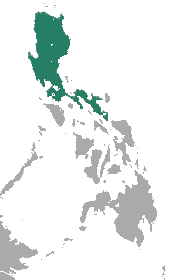Luzon fruit bat facts for kids
Quick facts for kids Luzon fruit bat |
|
|---|---|
| Conservation status | |
| Scientific classification | |
| Genus: |
Otopteropus
|
| Species: |
cartilagonodus
|
 |
|
| Luzon Fruit Bat range | |
The Luzon fruit bat (scientific name: Otopteropus cartilagonodus) is a type of megabat, also known as a fruit bat. It belongs to the Pteropodidae family. This bat is special because it's the only species in its group, called Otopteropus. You can only find it in the Philippines, making it endemic to those islands. It naturally lives in warm, dry forests.
Contents
What Does the Luzon Fruit Bat Look Like?
The Luzon fruit bat is a small bat found on Luzon island. It is part of the Chiroptera order, which includes all bats. Its fur is dark blackish-brown. Its belly area is usually a lighter grey color.
This bat is nocturnal, meaning it is active at night. It has fairly large eyes, especially for its small size. You can easily spot a Luzon fruit bat by its ears. They have unique red thickenings on them.
Differences Between Male and Female Bats
Male and female Luzon fruit bats show some interesting differences. This is called sexual dimorphism. Their skulls are different, especially in size. Males usually have larger skulls overall. However, females have a taller braincase. Because of this, females tend to have a longer total body length. Both males and females have similar wing bone lengths.
Where Do Luzon Fruit Bats Live?
The Philippine Islands are home to many different animals. For bats, there are 73 species, 36 groups (genera), and 6 families. The Luzon fruit bat is one of two species in its family that have spread out in Southeast Asia.
You can only find the Luzon fruit bat on Luzon Island in the Philippines. They live in three mountain ranges there:
- The Cordillera Central Mountains
- The Sierra Madre Mountains
- The Zambales Mountains
Scientists believe these three groups of bats became separate about 1.91 million years ago.
Preferred Habitats and Elevation
Luzon fruit bats are most common in old-growth forests in the mountains. These are forests that have been growing for a very long time. They also live in well-developed secondary forests. These are forests that have regrown after being disturbed. They can be found in lowland, montane (mountain), and mossy forests.
These bats live at elevations from about 200 to 2250 meters (about 650 to 7400 feet) above sea level. They seem to prefer areas at middle elevations. Because they live in high-up, less disturbed places, they are listed as a "Least Concern" species. This means they are not currently at high risk of extinction.
What Do Luzon Fruit Bats Eat?
The Luzon fruit bat is a frugivorous animal. This means its diet is mainly fruit or nectar. When they eat fruit, they help the forest grow. They do this by spreading seeds around. This helps new trees grow in different places.
Because male and female bats have different skull sizes, they might eat different foods. They tend to choose foods that are easiest for their body shape to handle.
Luzon Fruit Bat Life Cycle
These bats usually have one or two babies each year.


